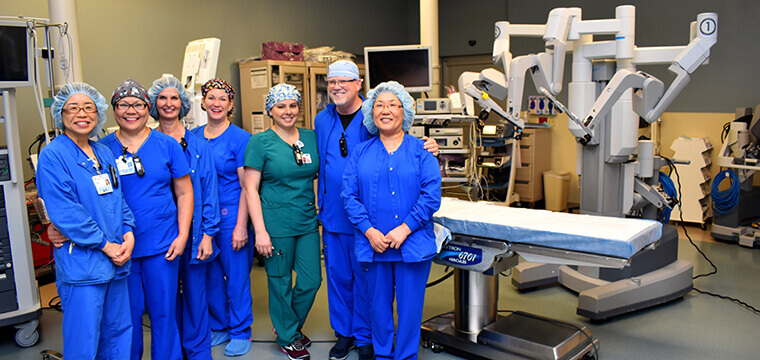Robotic-assisted Surgery with da Vinci is a Work of Art for Physicians

The St. Joseph's Hospital-North robotic surgery team.
When it comes to health care, patients have many options, even when it comes to surgical techniques. While many are familiar with open and laparoscopic surgery, technological advances have allowed physicians to perform increasingly complex procedures with better outcomes and recovery for patients with the use of robotics.
Robotic surgery refers to procedures that are done with the assistance of the da Vinci® Robotic Surgical System. “Contrary to what many think, it is not a robot operating on a patient,” explained Dr. Brett Armstrong, general and robotic surgeon at St. Joseph’s Hospital-North in Lutz. “In reality, the surgeon begins the procedure at the bedside, then performs the key portions of the procedure sitting at a console with their movements mimicked by robotic instruments.”
While robotic and laparoscopic surgery are both minimally invasive procedures, the da Vinci offers 3-D cameras for sharper, more life-like images while robotic arms interpret the surgeon’s hand motions and provide even more precise, stable, and accurate movements.
“Benefits of robotic surgery can be described as those for the patient and those for the surgeon,” said Dr. Armstrong. “In addition to less pain and faster recovery, patients also experience less bleeding and risk of infection, smaller incisions, shorter hospital stay, earlier return to work, and a decreased usage of opioid medications.”
Surgeons say the system allows better visualization, full use of their wrists, and better body ergonomics (as they are generally sitting rather than standing). This helps reduce small, unintended hand motions that can develop with long operative times.
An added benefit to both patients and surgeons is the additional safety measures with robotic surgery. “For example, using indocyanine green (ICG) dye, we are able to visualize biliary anatomy (the liver, gall bladder and bile ducts),” said Dr. Armstrong. “It can also be used to help evaluate blood flow and identify small but vital internal structures to help the surgeon avoid them during surgery.”
With robotic surgery, the optimal procedures are those where the working space is limited, such as near the diaphragm, in the pelvis, or in the chest. Hernia surgeries, for example, offer a unique use of the robot, with the ability to sew the repair mesh in place. The robot is being used with more and more frequency for urologic, gynecologic, cardiothoracic, and colorectal surgeries as well.
The choice to have open, laparoscopic or robotic surgery is a decision that should be made between the patient and the surgeon. “Some procedures are so short or so straightforward that the robotic technology is really not necessary (for example, an appendectomy),” Dr. Armstrong explained. “Some surgeries are too complex even for the robotic system, and thus are performed open.”
It is most important to ask about your surgeon’s comfort and experience level with the robot. According to Dr. Armstrong, “Ultimately, the best surgery to be performed is the one your surgeon is most comfortable and experienced with.”
For more information about robotic surgery, visit BayCareRobotics.org.

